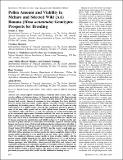| dc.description.abstract | East African diploid cooking bananas, commonly called Mchare, are a staple crop for millions of subsistence farmers in Tanzania, particularly in the Pangani region in northern Tanzania. Several pathogens constrain Mchare production significantly and threaten food security. Sources of resistance to these pathogens have been identified; however, partial male and female sterility impedes successful resistance introgression, complicating the breeding process. Mchare cultivars are also the only known surviving representatives of a diploid banana subgroup that contributed unreduced gametes to many of the most widely grown and successful triploid dessert bananas (‘Cavendish’, ‘Gros-Michel’, ‘Silk’, and ‘Prata’). As such, they represent an essential intermediate step in the conventional improvement of bananas worldwide. We assess the amount and viability of pollen among Mchare and wild genotypes to identify the most fertile Mchare cultivars that can be used in conventional banana improvement. Pollen was collected from 14 banana genotypes for quantification and viability testing over 7 months, and the optimal time for pollen collection was determined to be 0800 HR. Significant variation among banana genotypes in terms of both overall pollen production and percentage of pollen viability was observed. The wild-type bananas ‘Calcutta 4’ [International Musa Germplasm Transit Center (ITC) 0249] and ‘Borneo’ (ITC0253) had the greatest overall pollen production (> 31,000 pollen grains/anther) and viability (∼74%), whereas ‘Ijihu Inkundu’ (ITC1460; Mchare genotype) was the least productive (almost completely sterile), with an average pollen production of a few hundred grains per anther and a viability of 7%. There were significant differences among months in terms of pollen viability, with the greatest average viability observed in May, April, and February (> 51%), and the lowest average pollen viability in July (41%). Significant differences were observed among the Mchare genotypes, with ‘Huti-White’, ‘Huti green bell’ (ITC1559), and ‘Mchare Laini’ consistently producing more substantial amounts of total pollen and an overall more significant proportion of viable pollen. This information is vital to improve Mchare bananas and the global breeding of dessert bananas. The choice of Mchare banana used in improvement programs could affect fertility and the likelihood of breeding success. | en_US |

